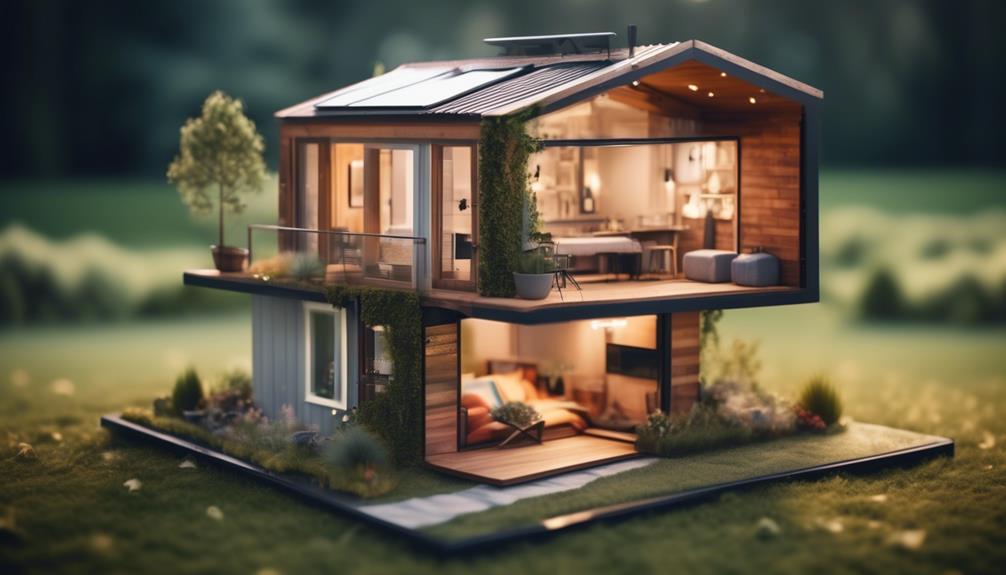You might think that your tiny home, much like your collection of vintage teacups, is so light and quaint that the scales would barely notice it—yet, ironically, that's where you'd be mistaken.
As you embark on the journey to downsize your life, it's essential to understand that the weight of a tiny home isn't just about whether you can heft it with your bare hands; it's a complex equation involving trailer capacity, material choices, and the laws of physics.
You'll need to balance the rigors of road safety with the finesse of space optimization, ensuring your movable abode doesn't transform into an immovable object. While you might be equipped with the enthusiasm of a minimalist, don't let the scale of the challenge catch you off guard.
Stay with this conversation to uncover the intricacies of tiny home weights, and learn the tips that will help you skirt the fine line between portability and stability.
Key Takeaways
- Calculation of weight is crucial for safety, mobility, and legal compliance when it comes to tiny homes.
- Choosing lightweight materials and accurately measuring each component is important to stay within safe weight limits.
- Balanced weight distribution across the tiny home trailer is essential to mitigate axle stress and prevent towing issues.
- Proper selection and maintenance of towing equipment, as well as careful site selection, are necessary for safe transportation and stability of the tiny home.
Understanding Tiny Home Weights
Grasping the specifics of your tiny home's weight is crucial for safety, mobility, and legal compliance. The Tiny House Weight encompasses not only the structure itself but also the contents within. Precise calculation of the weight ensures that the Axle Weight Rating (AWR) of your trailer isn't exceeded. Overlooking this can lead to structural failure or legal infractions.
The Tongue Weight, or the force exerted on the hitch when attached, needs fine-tuning for optimal weight distribution and towability.
Assessing Trailer Weight against the Vehicle Weight Rating (VWR) of your towing vehicle is imperative. A mismatch can impair driving dynamics and cause undue strain on your vehicle. Therefore, you must calculate the weight with analytical rigor, considering all variables to achieve an equilibrium that promotes transportability and adherence to weight regulations.
Weight Calculation Basics
You'll need to start by identifying key components of your tiny home that contribute to its total mass. Estimating the weight of these individual elements with precision allows you to calculate the overall mass accurately.
This step is critical for ensuring your tiny home meets transportation regulations and maintains structural integrity during mobility.
Identify Key Components
When calculating the weight of your tiny home, it's crucial to start by understanding the trailer's load capacity, including its dry weight and Gross Vehicle Weight Rating (GVWR). To ensure you're on the right track, focus on these components:
- Trailer Specifications: Assess the trailer's tongue weight capacity and the strength of its axles. Remember, upgrading axles doesn't necessarily equate to a safer towing capacity.
- Building Materials: Calculate the weight of all the materials you plan to use. Opt for innovative, lightweight options that don't compromise structural integrity.
- Weigh Stations: Utilize weigh stations to gauge your tiny house's loaded weight, ensuring it falls within the trailer's GVWR.
- Weight Distribution: Analyze the distribution of weight to maintain balance, preventing undue stress on the trailer while in motion.
Estimating Total Mass
To accurately estimate your tiny home's total mass, it's essential to account for both the base weight of the trailer and the cumulative weight of building materials, furnishings, and personal belongings.
Begin by determining the dry weight of the trailer—Weigh your empty trailer to establish a baseline.
Next, Weigh the materials you use during construction to ensure precision in your calculations. Include the weight of both fixed and movable objects within the tiny house total weight estimate. This calculation will give you an estimate of your final weight.
Remember to consider weight distribution and balance for safe towing.
Additionally, add a buffer for the weight to accommodate any unforeseen additions and to ensure compliance with GVWR, GCWR, and GAWR limits.
Material and Content Impact

As you plan your tiny home, it's imperative to meticulously assess the weight of building materials, furniture, and appliances, as these elements significantly influence the overall weight and, by extension, the safety and mobility of your home.
Here are key considerations:
- Choose Lightweight Materials: Opt for materials that offer strength without excessive weight. This is crucial in maintaining a manageable final weight.
- Weigh the Materials You Use: Accurately measure each component to ensure you stay within safe weight limits.
- Consider the Contents of Your Tiny Home: Every item adds to the weight. Be strategic in selecting essentials.
- Add a Buffer for the Weight: Anticipate future additions by designing your tiny home with a weight margin to accommodate extra belongings without compromising safety.
Weight Distribution Importance
You must ensure your tiny home's weight is balanced evenly across its structure to mitigate axle stress and enhance towing stability. Uneven load distribution can lead to premature wear on your trailer's components and pose significant safety risks on the road.
Consulting with professional engineers is advisable to calculate precise load balances, considering the optimal tongue weight should be within 10-15% of your tiny house's total weight.
Balancing Load Evenly
Ensuring balanced weight distribution across your tiny home trailer is a critical step for maintaining towing stability. When building a tiny house, it's essential to consider the trailer's weight rating and the weight of a tiny home. Here's what you need to focus on:
- Weigh the materials you use: Precision in measuring the weight of each component ensures that you're within the tiny house's weight limits.
- Balance the load: Distribute the weight evenly from side to side and front to back to avoid towing issues.
- Consider tongue weight: Aim for the appropriate percentage of the total tiny house's weight to prevent sway during towing.
- Add a buffer for the weight: Allow for additional weight as a precaution to prevent overloading.
Balancing load evenly isn't just beneficial—it's imperative for safety and longevity.
Axle Stress Reduction
To reduce axle stress and enhance towing safety, it's imperative to adhere to recommended weight distribution guidelines across your tiny home's trailer. Balancing the weight of your tiny house side to side and front to back isn't just a suggestion—it's a technical necessity.
The combined weight should be distributed in a way that minimizes the strain on any single point, particularly the axles. This precise balance ensures that the tow vehicle can manage the load effectively, avoiding undue pressure on the trailer that the house sits upon. Specifically, the tongue of the trailer must bear an appropriate amount of weight to prevent sway and maintain stability during transit.
Consulting with professional engineers for axle stress reduction strategies can result in innovative solutions tailored to your unique tiny house towing requirements.
Stability on the Road
While adhering to weight distribution guidelines reduces axle stress, it also significantly bolsters your tiny home's stability during transport. To ensure your tiny house remains steadfast on the road, consider the following technical aspects:
- Tow Vehicle Compatibility: Match your tiny house trailer to a tow vehicle that can handle the combined weight, ensuring the powertrain and brakes are adequate.
- Trailer Balance: Distribute weight evenly side to side and prioritize a front-to-back balance to maintain control.
- Tongue Weight: Aim for the tongue weight to be 10-15% of the overall trailer weight, creating sufficient downward force on the hitch for stability.
- Professional Assessment: Consult with an engineer for a ball park estimate on weight distribution, ensuring your setup meets safety standards and reduces the risk of hazards.
Transportation and Mobility
When transporting your tiny home, it's essential to prioritize proper weight distribution to guarantee safe towing. Precisely balancing the weight of your tiny house on the trailer ensures that the hitch of the tow vehicle bears an optimal load, preventing sway and maintaining control.
The choice of tow vehicle mustn't be arbitrary; it must possess a towing capacity that exceeds the total weight of your tiny house, considering the weight on their hitch. Innovative tiny house enthusiasts must also account for increased fuel consumption correlated with the mass of their mobile abodes.
Analyze road conditions and anticipate potential obstacles to minimize transit risks. Lastly, a rigorous maintenance schedule for your trailer's towing equipment is non-negotiable to uphold transport safety.
Site and Foundation Selection

Having established the importance of weight distribution for safe towing, let's now focus on the significance of selecting an appropriate site and foundation to ensure your tiny home's stability and compliance with local standards.
When considering site selection and foundation building for your tiny house, integrate these critical elements:
- Choose a site with flat terrain and firm ground support to enhance stability under your trailer's weight.
- Evaluate soil conditions, drainage, and accessibility to ensure the foundation supports long-term stability.
- Verify that the site adheres to local regulations and zoning requirements, crucial for legal compliance.
- Opt for a location with good road access and minimal obstacles, facilitating easier positioning and connection to your tow vehicle.
Precision in these choices will safeguard your investment and foster innovative tiny house living.
Frequently Asked Questions
How Can I Save Weight in My Tiny House?
To save weight in your tiny house, choose lightweight materials, space-saving furniture, and multifunctional designs. Embrace minimalist living, focus on structural optimization, smart weight distribution, and innovative storage solutions for efficiency.
What Are 3 Negative Features of a Tiny House?
You'll face space constraints, minimal storage, and limited privacy, alongside zoning issues, resale difficulty, and financing challenges. Adapting requires a significant lifestyle adjustment, demanding ingenuity in your compact living solution.
What I Need to Know About Building a Tiny Home?
You'll need to navigate zoning laws, choose a robust foundation, select durable materials, innovate with storage solutions, ensure reliable utility connections, and meticulously plan your budget for your cutting-edge tiny home design choices.
How Do I Prepare for a Tiny House?
You're crafting a new beginning with space optimization, embracing minimalist living. Navigate zoning laws, select a robust foundation, and consider mobility plans. Explore off-grid options and make lifestyle adjustments for a sustainable, innovative future.
Conclusion
In conclusion, remember that 'a stitch in time saves nine.' Precisely calculating your tiny home's weight ensures safe travels and a sturdy abode. Factor in materials, contents, and weight distribution meticulously.
Choose your site and foundation with the same rigor. By doing so, you'll avoid future hassles, ensuring your tiny haven is both mobile and durable.
Stay informed, stay safe, and enjoy the freedom your well-planned tiny home offers.

